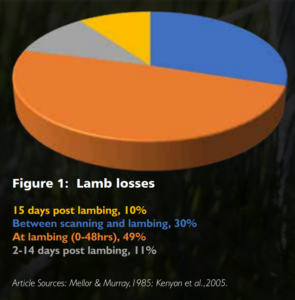Industry standards suggest that annual lamb losses on lowland farms in the UK is estimated to be 15%. Losses in hill flocks are thought to be lower, however, the reduction in potential lamb output will detrimentally impact business profitability in any system, there fore quality nutrition in early life is crucial.

Industry standards suggest that annual lamb losses on lowland farms in the UK are estimated to be 15%. Losses in hill flocks are thought to be lower, however, the reduction in potential lamb output will detrimentally impact business profitability in any system. Most lamb losses occur during pregnancy or in the first few weeks of life, with 49% of losses occurring in the first 48 hours after lambing (Figure 1). Much of this loss is preventable and primarily occurs due to a lack of sufficient quantities of adequate quality colostrum in the first 24 hours post lambing.
The first few hours after birth are critical for the survival of the newborn lamb. Ensuring an adequate supply of good quality colostrum is key in supporting lamb health, performance, and survivability. Colostrum is a nutrient-dense feed that contains a higher fat, protein, and mineral content than ewe’s milk. Not only does colostrum provide essential nutrients to the newborn lamb, but it also stimulates digestive activity and contains immunoglobulins that function as antibodies to support the immune system. Following colostrum feeding, the choice of a lamb milk replacer for artificially reared lambs must be carefully considered.
Newborn lambs have limited energy reserves so early provision of adequate energy in a highly digestible form is therefore essential to support early life survivability, body temperature maintenance, immune system support, daily live weight gains and optimal development for flock replacements. Adverse weather conditions during the lambing period can further exacerbate body heat loss increasing these requirements even further.
Protein quality and digestibility is also a key consideration. Selecting a lamb milk replacer containing 100% of protein from dairy sources maximises digestibility and availability of nutrients which in turn supports lamb performance, particularly for that young lamb. Osmolality measures the concentration of solute particles in a solution and is calculated by adding the concentrations of sugars and minerals in mOsm/kg of solvent. Lamb milk replacers with elevated levels of osmolality can damage gut integrity, increase the risk of abomasal bloat and potentially exacerbate diarrhoea severity in sick lambs. Choosing a product that has been carefully formulated with osmolality in mind will help to reduce the risk of diarrhoea.
A recommended lamb milk replacer, available from NWF Agriculture, is Milkivit Energized Lamb Milk. Available as a 50% skim or whey product. The formulation has been carefully designed to help lambs achieve their full growth potential
and has been specifically developed with four key benefits in mind:
• Improved energy density
• Optimal protein digestibility
• Controlled osmolality
• Careful mineral & vitamin supplementation
For more information on NWF Lamb Milk Replacers or our Ewe & Lamb Feeds, speak to your local NWF Sales Specialist or click HERE.

